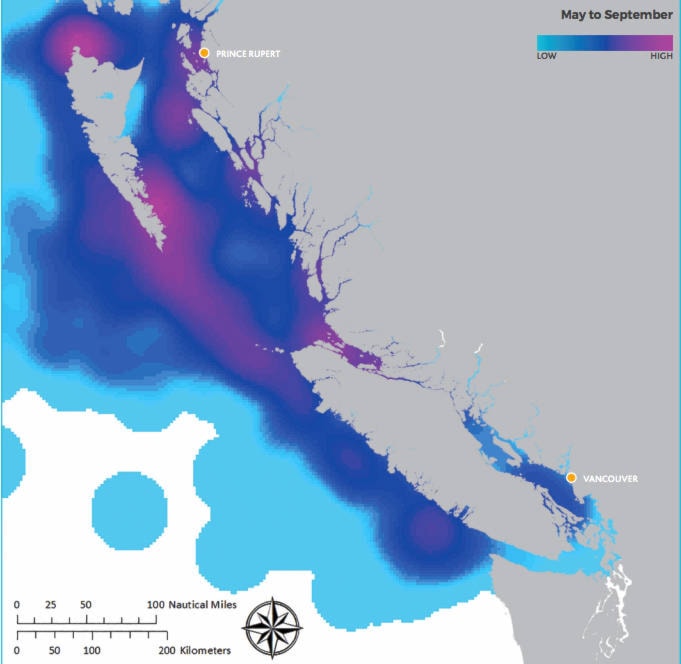Boaters need to be extra alert and ready to slow for humpback whales and other cetaceans in Haida Gwaii fishing grounds.
That’s a key message from the Marine Education and Research Society (MERS), which has launched a campaign to try and reduce the number of whale strikes along the B.C. coast.
“People don’t usually talk about it,” says Jackie Hildering, a humpback researcher and society director.
“The increasing number of humpbacks — the fortunate second chance with them — is a game-changer for boaters.”
Hildering spoke to the Observer a week after two people were seriously injured when their guided fishing boat suddenly struck a humpback whale in Virago Sound on June 25.
No one on the boat had a chance to see the whale surface. They hit at a cruising speed of over 20 knots.
“See a blow? Go slow” is the MERS campaign slogan, which also recommends boaters look for flocks of birds on the water as a sign whales may be feeding on schooling fish.
But in this case and others, Hildering said humpbacks can also surface without warning.
“They’re very different than the orca that people are used to on the water,” she said.
Caitlin Birdsall, a researcher with the Vancouver Aquarium, agrees it’s not always easy for boaters to know when humpbacks are nearby.
“This is unfortunately the new realm we’re dealing with now that we have more humpbacks on the coast, which is a great thing, but we want to make sure people and whales are safe.”
While pods of orca usually travel in a single direction and are very surface active, around Haida Gwaii and other summer feeding areas, humpbacks may be spread out and diving.
Unlike toothed whales, humpbacks and other baleen whales also lack biological sonar to warn them of approaching boats.
“They can be astoundingly oblivious to boats,” said Hildering, adding that she has had some close calls herself while researching humpbacks. When just under the surface, she said they can be tougher to see than a log.
“They’re really, really hungry when they come to our waters because they are most likely coming back from Hawaii, where there is little to no food for them,” she added.
“They feed like crazy when they’re here, they’re taking long dives, and they’re usually travelling really rapidly.”
Given that behaviour, Hildering said it’s important boaters know where they can expect high densities of humpbacks, which very often return to the same feeding grounds year after year, as well as other cetaceans.
In 2009, Fisheries and Oceans Canada identified the waters around Langara Island and southeast Moresby Island as two of the four critical habitat areas for humpbacks in B.C.
Only 30 cetacean-vessel strikes were reported to the BC Marine Mammal Response Network and investigated by DFO in the eight years between 2004 and 2011. One was a humpback hit near Langara Island, the other a humpback hit east of Skincuttle Inlet.
A cetaceans guide published earlier this year for mariners piloting large vessels — container ships, cruise ships, ferries — recommends speeds of 10 knots or less in areas with high densities of cetaceans.
On the Atlantic coast of the U.S., anyone piloting ships 65 metres or longer is legally required to travel under 10 knots in areas that tend to have many North Atlantic right whales — a change that has reduced strike-related deaths of the endangered species by 80 to 90 per cent.
Hildering said she and MERS are planning to visit Haida Gwaii next spring to talk about the issue and, hopefully, to put up some of the whale-strike warning signs that MERS and the Vancouver Aquarium are placing in areas where they might be helpful.
At roughly 54,000 worldwide, humpbacks have recovered to just over 45 per cent of what is believed to be their historical population, but they are second only to fin whales as those most likely to be struck by boats and ships.
Given the high number of whales seen in B.C. waters with scars from boat propellors and hulls, it’s clear that many strikes go unreported — possibly because crews on larger vessels don’t know they’ve hit.
To report a whale strike, entanglement, or carcass at sea, call the B.C. Marine Mammal Response Network at 1-800-465-4336.
Sightings of whales and other cetaceans can be reported to the B.C. Cetacean Sightings Network at 1-866-I-SAW-ONE (1-866-472-9663) or using the Vancouver Aquarium’s Whale Report app for Android and Apple devices.
